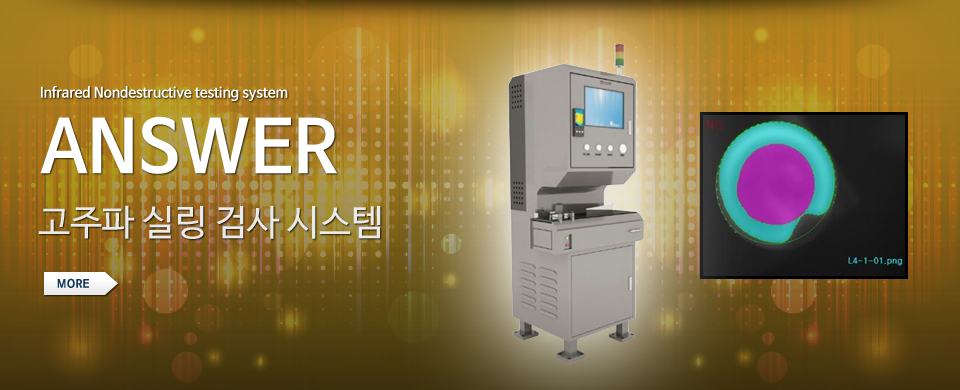|
|
|
본문
Medical Diagnostics
|
| | |
Being not energetic enough to break
chemical bonds or ionize molecules / atoms, Terahertz photons are harmless for
living organisms, as opposed to higher energy photons such as x-rays and UV rays
that are considered to be so bad for us. As it is safe for humans, THz imaging*
technology has opened up infinite opportunities for medicine, that like other
applications can surely benefit from penetrating capability of Terahertz waves
to make the invisible visible and visualize internal information about physical
objects. |
| | Terahertz radiation is non-ionizing and
is not highly scattered in tissues (unlike optical emission). Besides, there are
strong water | | | absorptions in the terahertz
region of the electromagnetic spectrum, which therefore means that imaging using
terahertz radiation would be a useful tool to investigate soft tissues. These
unique properties of T-rays make them eligible for use in various medical
applications, some of which hold enormous promise for certain aspects of
diagnostics as described below. | | A | | A |
| Non-invasive technique for early
detection of many pathological conditions: viz. cancers at early stages (skin
cancer, breast cancer, colon cancer etc.) | | 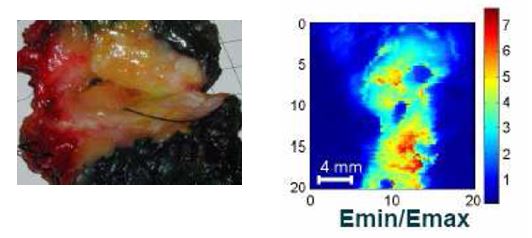 The most recent achievements in the field of medical
imaging have dramatically enhanced the early detection and treatment of many
pathological conditions. THz imaging systems can help detect the early cancer
before it is visible or sensitive to any other identification means.
The latest research
aimed at examining terahertz properties on skin cancer, breast and colon cancer
tissues discovered that refractive index and absorption coefficient of the tumor
tissue are higher in comparison to the normal tissue. Such distinction is
possible due to higher water content and structural changes that occur in
carcinoma (e.g. increased cell and protein density observed in cells affected by
disease). Terahertz pulse imaging technique is highly sensitive to water
concentration (because of the latter attenuation) and therefore water absorption
is evident in the terahertz properties measured for soft tissues, which explains
the contrast seen between muscle and adipose tissue, for instance. The most recent achievements in the field of medical
imaging have dramatically enhanced the early detection and treatment of many
pathological conditions. THz imaging systems can help detect the early cancer
before it is visible or sensitive to any other identification means.
The latest research
aimed at examining terahertz properties on skin cancer, breast and colon cancer
tissues discovered that refractive index and absorption coefficient of the tumor
tissue are higher in comparison to the normal tissue. Such distinction is
possible due to higher water content and structural changes that occur in
carcinoma (e.g. increased cell and protein density observed in cells affected by
disease). Terahertz pulse imaging technique is highly sensitive to water
concentration (because of the latter attenuation) and therefore water absorption
is evident in the terahertz properties measured for soft tissues, which explains
the contrast seen between muscle and adipose tissue, for instance. | | . | | Consequently, T-ray images can distinguish
between healthy tissue and basal cell carcinoma and therefore help in mapping
the exact margins of tumors in earlier stages. (The most promising are such
non-invasive terahertz imaging techniques as THz pulse imaging, THz time domain
spectroscopy (TDS-THz), continuous wave terahertz (CW-THz), and other THz
generation/detection methods). | | . | | Ex-vivo
spectroscopy / imaging of tissues (biopsy) | | . | 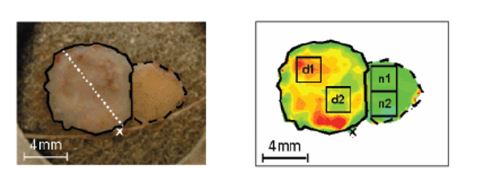 By obtaining both frequency and time domain
information, Teraherz imaging can ensure enhanced detection of cancer (and other
inflammation areas), and provide sharper imaging and molecular fingerprinting.
Each year millions of biopsies of breast tissues are required to compensate for
uncertain, inaccurate or negligent diagnoses delivered by means conventional
detection methods, which are not always impeccable. By obtaining both frequency and time domain
information, Teraherz imaging can ensure enhanced detection of cancer (and other
inflammation areas), and provide sharper imaging and molecular fingerprinting.
Each year millions of biopsies of breast tissues are required to compensate for
uncertain, inaccurate or negligent diagnoses delivered by means conventional
detection methods, which are not always impeccable. | | Terahertz time-domain spectroscopy (TDS-THz) can
breach the shortcomings of other medical diagnostics in rendering adequate
images of the affected tissues or suspected areas. Many researchers confirm that
at certain frequency range most tumors have lower absorption than normal
tissues. The obvious conclusion here is that THz imaging can ‘distinguish’ the
tumors (inflamed areas) from normal tissues. In addition to helping save human
lives, such biopsies enhanced by T-ray spectroscopy saves a lot of time and
efforts by reducing the number of second surgical procedures in breast and skin
cancer treatment cases. | | . | | One of the greatest biomedical potential of
T-ray imaging is associated with Molecular spectroscopy for diagnostics, which
is exponentially advanced and moved closer by the progress. | | . | | In-vivo
examination of tissue via spectroscopy / imaging | | . | 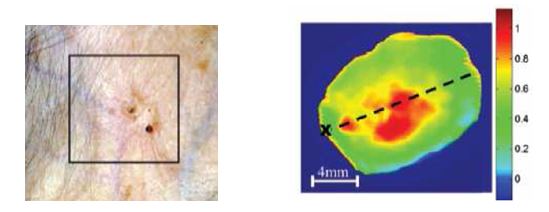 Surgeons during a carcinectomy surgery –just to stay on
the safe side – excise the tumor with an ample margin of healthy tissue
surrounding it. Such playing-it-safe approach in surgery is often justified but
costs dearly to patients and fires back on regeneration/recovery period.
Imaging in THz
frequency range can be used to render a real-time imaging during surgical
operations to avoid cutting off a lot of healthy tissue, and exclude leaving any
part of carcinoma in a patient’s body. This in its turns considerably reduces
the likelihood of the need for a repeated invasive operative intervention(s) in
the future. Surgeons during a carcinectomy surgery –just to stay on
the safe side – excise the tumor with an ample margin of healthy tissue
surrounding it. Such playing-it-safe approach in surgery is often justified but
costs dearly to patients and fires back on regeneration/recovery period.
Imaging in THz
frequency range can be used to render a real-time imaging during surgical
operations to avoid cutting off a lot of healthy tissue, and exclude leaving any
part of carcinoma in a patient’s body. This in its turns considerably reduces
the likelihood of the need for a repeated invasive operative intervention(s) in
the future. | |
| 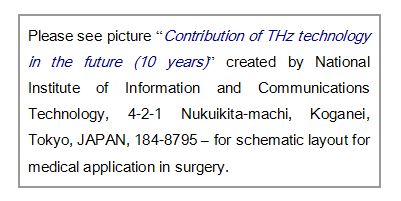 Terahertz imaging (especially THz Pulse Imaging (TPI)
can show good contrast between different animal tissue types and, accordingly,
can enhance the effectiveness of medical diagnostics and tangibly complement
histological analysis. Such diagnostic is believed to allow obtaining the
spectrum of each pixel in the image individually. Those spectra that represent
different tissue types happen to be markedly different. This suggests that the
spectral data inherent in T-ray image might be used to distinguishing between
soft and hard tissue at each pixel in an image and provide other diagnostic
information not afforded by currently available conventional imagine
techniques. Terahertz imaging (especially THz Pulse Imaging (TPI)
can show good contrast between different animal tissue types and, accordingly,
can enhance the effectiveness of medical diagnostics and tangibly complement
histological analysis. Such diagnostic is believed to allow obtaining the
spectrum of each pixel in the image individually. Those spectra that represent
different tissue types happen to be markedly different. This suggests that the
spectral data inherent in T-ray image might be used to distinguishing between
soft and hard tissue at each pixel in an image and provide other diagnostic
information not afforded by currently available conventional imagine
techniques. | | |
In vivo
molecular imaging is considered as the next frontier in medical diagnostics,
which in the ideal situation, would be performed non-invasively.
REFERENCE:
Hosako, N. Sekine, N. Oda, M. Sano, S.. Kurashina, M. Miyoshi et al., A
real-time terahertz imaging system consisting of terahertz quantum cascade laser
and uncooled microbolometer array detector, SPIE Vol. 8023, 80230A, doi:
10.1117/12.887947/ (available at: http://spie.org/newsroom/technical-articles-archive/3651-terahertz-imaging-for-detection-or-diagnosis) | | | | . | | Dental
care | | . | 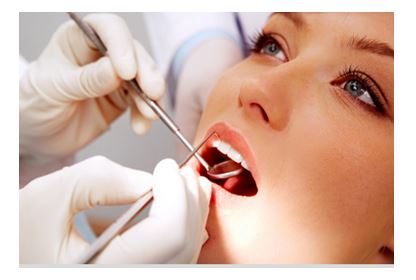 Modern scientific research evidence strongly suggests
that THz Pulse Imaging my be used to provide valuable diagnostic information
pertaining to the enamel, dentine, and the pump cavity.
Many
researchers have consensus that the time-of-flight of THz pulses through the
tooth allows to make highly important measurements for a dentist, none the least
of which is the thickness of the enamel that can be determined this way.
Moreover, it can be used to create an image showing the enamel and dentine
regions. Additionally, pulp cavity regions can be identified via absorption of
THz pulses in the tooth and allow a dentist to chose the right treatment on the
spot. Modern scientific research evidence strongly suggests
that THz Pulse Imaging my be used to provide valuable diagnostic information
pertaining to the enamel, dentine, and the pump cavity.
Many
researchers have consensus that the time-of-flight of THz pulses through the
tooth allows to make highly important measurements for a dentist, none the least
of which is the thickness of the enamel that can be determined this way.
Moreover, it can be used to create an image showing the enamel and dentine
regions. Additionally, pulp cavity regions can be identified via absorption of
THz pulses in the tooth and allow a dentist to chose the right treatment on the
spot. | | . | | Preventive
healthcare and blood testing | | . |  Quite a few medical R&D projects lead to
conclusions that terahertz (THz) time-domain spectroscopy (TDS) can be used to
characterize the blood. Scientists in this field have already obtained the
complex optical constants of blood and its constituents, such as water, plasma,
and red blood cells (RBCs) in the THz frequency region. Researcher managed to
extract the volume percentage of RBCs in blood and compare it with the
conventional RBC counter results. The THz absorption constants proved to vary
linearly with the RBC concentration in both normal saline and whole blood. The
excellent linearity between the THz signal and the RBC concentration was also
confirmed in a polyurethane resin tube using a THz imaging method. These results
demonstrate that THz-TDS imaging can facilitate the quantitative analysis of
blood. Quite a few medical R&D projects lead to
conclusions that terahertz (THz) time-domain spectroscopy (TDS) can be used to
characterize the blood. Scientists in this field have already obtained the
complex optical constants of blood and its constituents, such as water, plasma,
and red blood cells (RBCs) in the THz frequency region. Researcher managed to
extract the volume percentage of RBCs in blood and compare it with the
conventional RBC counter results. The THz absorption constants proved to vary
linearly with the RBC concentration in both normal saline and whole blood. The
excellent linearity between the THz signal and the RBC concentration was also
confirmed in a polyurethane resin tube using a THz imaging method. These results
demonstrate that THz-TDS imaging can facilitate the quantitative analysis of
blood.
| 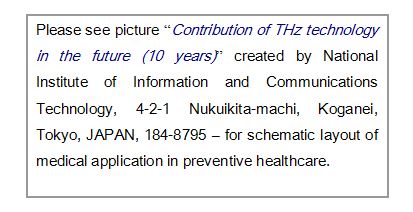 Additionally, very recent research project in THz
emission at the level of a few tens of GHz and at 300 GHz showed sensitivity to
the blood glucose level. This invention opened immense opportunities for
preventive healthcare (blood analysis) for non-invasive measurement of glucose
and other biomedical relevant molecules involving sub-THz and Terahertz ranges,
up from aprx. 20GHz on. It is now evident that different types of biomolecules
leave distinctive spectral fingerprints in the THz region, which considerably
widens the coverage of THz technologies application to include in-vitro and
in-vivo measurements of small molecules (such as glucose, lactate, urea) of
clinical importance in PoC and diagnostic systems. Additionally, very recent research project in THz
emission at the level of a few tens of GHz and at 300 GHz showed sensitivity to
the blood glucose level. This invention opened immense opportunities for
preventive healthcare (blood analysis) for non-invasive measurement of glucose
and other biomedical relevant molecules involving sub-THz and Terahertz ranges,
up from aprx. 20GHz on. It is now evident that different types of biomolecules
leave distinctive spectral fingerprints in the THz region, which considerably
widens the coverage of THz technologies application to include in-vitro and
in-vivo measurements of small molecules (such as glucose, lactate, urea) of
clinical importance in PoC and diagnostic systems. | |
REFERENCE:
Hosako, N. Sekine, N. Oda, M. Sano, S.. Kurashina, M. Miyoshi et al., A
real-time terahertz imaging system consisting of terahertz quantum cascade laser
and uncooled microbolometer array detector, SPIE Vol. 8023, 80230A, doi:
10.1117/12.887947/ (available at: http://spie.org/newsroom/technical-articles-archive/3651-terahertz-imaging-for-detection-or-diagnosis) | | . | | Non-destructive testing of pharmaceutical
products | | . |  Pharmaceutical R&D projects that target drug discovery quite
frequently resort to tracking molecular interactions using chemical ‘labels’
that are costly and are often prone to error. The research conducted by Dr.
Naoki Oda, Guidance and Electro-Optics Division of NEC Corporation
and Dr. Iwao Hosako, National Institute of Information and
Communications Technology, employed THz camera to achieve
label-free detection of small-molecule reactions with proteins. The THz waves
were observed to be absorbed readily and enabled sensing of very small changes
in biomaterials. The detection sensitivity of a label-free biotin-streptavidin
reaction (routinely used in biotechnology), for example, was nearly the same as
that of conventional methods, which enable the use of THz imaging system for
Non-destructive testing for pharmaceutical products.Of coarse, a high speed THz system has
the advantage of high throughput and low cost in this respect. Pharmaceutical R&D projects that target drug discovery quite
frequently resort to tracking molecular interactions using chemical ‘labels’
that are costly and are often prone to error. The research conducted by Dr.
Naoki Oda, Guidance and Electro-Optics Division of NEC Corporation
and Dr. Iwao Hosako, National Institute of Information and
Communications Technology, employed THz camera to achieve
label-free detection of small-molecule reactions with proteins. The THz waves
were observed to be absorbed readily and enabled sensing of very small changes
in biomaterials. The detection sensitivity of a label-free biotin-streptavidin
reaction (routinely used in biotechnology), for example, was nearly the same as
that of conventional methods, which enable the use of THz imaging system for
Non-destructive testing for pharmaceutical products.Of coarse, a high speed THz system has
the advantage of high throughput and low cost in this respect. | | A | | Please see schematic layout for medical
application in quality control and non-destrcutive testing - in picture
“Contribution of THz technology in the future (10 years)” created by
National Institute of Information and Communications Technology, 4-2-1
Nukuikita-machi, Koganei, Tokyo, JAPAN, 184-8795.
REFERENCE:
Hosako, N. Sekine, N. Oda, M. Sano, S.. Kurashina, M. Miyoshi et al., A
real-time terahertz imaging system consisting of terahertz quantum cascade laser
and uncooled microbolometer array detector, SPIE Vol. 8023, 80230A, doi:
10.1117/12.887947/ (available at: http://spie.org/newsroom/technical-articles-archive/3651-terahertz-imaging-for-detection-or-diagnosis) | | . | | Other
medical areas – e.g. diagnostics of osteoarthritis and arthritis
| | . |  There are also many other areas in medicine which would
benefit from both an intra-operative probe and post-operative analysis of soft
tissues sensitive to THz light.
Osteoarthritis (OA)
is the most common form of arthritis, caused by the breakdown of cartilage would
be one vivid example. It usually affects weight-bearing joints like hip, knee,
feet and spine, which causes the joints to degenerate. After cartilage erosion,
bone grinding may occur, leading to thickening and forming of osteophytes, and,
As a result, pain, stiffness, swelling and reduced range of motion.
OA and many
other diseases would be a great medical incentive to investigate the in vivo
usage of terahertz imaging. There are also many other areas in medicine which would
benefit from both an intra-operative probe and post-operative analysis of soft
tissues sensitive to THz light.
Osteoarthritis (OA)
is the most common form of arthritis, caused by the breakdown of cartilage would
be one vivid example. It usually affects weight-bearing joints like hip, knee,
feet and spine, which causes the joints to degenerate. After cartilage erosion,
bone grinding may occur, leading to thickening and forming of osteophytes, and,
As a result, pain, stiffness, swelling and reduced range of motion.
OA and many
other diseases would be a great medical incentive to investigate the in vivo
usage of terahertz imaging. | | . | *Footnotes: All in
all there are several Terahertz imaging modalities that represent high interest
for medicine, in particular, Terahertz pulsed imaging (TPI), THz time domain
spectroscopy (TDS-THz), continuous wave terahertz (CW-THz), and a few other THz
generation/detection methods.
All in
all there are several Terahertz imaging modalities that represent high interest
for medicine, in particular, Terahertz pulsed imaging (TPI), THz time domain
spectroscopy (TDS-THz), continuous wave terahertz (CW-THz), and a few other THz
generation/detection methods.
|
|
|
 The most recent achievements in the field of medical
imaging have dramatically enhanced the early detection and treatment of many
pathological conditions. THz imaging systems can help detect the early cancer
before it is visible or sensitive to any other identification means.
The most recent achievements in the field of medical
imaging have dramatically enhanced the early detection and treatment of many
pathological conditions. THz imaging systems can help detect the early cancer
before it is visible or sensitive to any other identification means.
 By obtaining both frequency and time domain
information, Teraherz imaging can ensure enhanced detection of cancer (and other
inflammation areas), and provide sharper imaging and molecular fingerprinting.
Each year millions of biopsies of breast tissues are required to compensate for
uncertain, inaccurate or negligent diagnoses delivered by means conventional
detection methods, which are not always impeccable.
By obtaining both frequency and time domain
information, Teraherz imaging can ensure enhanced detection of cancer (and other
inflammation areas), and provide sharper imaging and molecular fingerprinting.
Each year millions of biopsies of breast tissues are required to compensate for
uncertain, inaccurate or negligent diagnoses delivered by means conventional
detection methods, which are not always impeccable. Surgeons during a carcinectomy surgery –just to stay on
the safe side – excise the tumor with an ample margin of healthy tissue
surrounding it. Such playing-it-safe approach in surgery is often justified but
costs dearly to patients and fires back on regeneration/recovery period.
Surgeons during a carcinectomy surgery –just to stay on
the safe side – excise the tumor with an ample margin of healthy tissue
surrounding it. Such playing-it-safe approach in surgery is often justified but
costs dearly to patients and fires back on regeneration/recovery period.
 Terahertz imaging (especially THz Pulse Imaging (TPI)
can show good contrast between different animal tissue types and, accordingly,
can enhance the effectiveness of medical diagnostics and tangibly complement
histological analysis. Such diagnostic is believed to allow obtaining the
spectrum of each pixel in the image individually. Those spectra that represent
different tissue types happen to be markedly different. This suggests that the
spectral data inherent in T-ray image might be used to distinguishing between
soft and hard tissue at each pixel in an image and provide other diagnostic
information not afforded by currently available conventional imagine
techniques.
Terahertz imaging (especially THz Pulse Imaging (TPI)
can show good contrast between different animal tissue types and, accordingly,
can enhance the effectiveness of medical diagnostics and tangibly complement
histological analysis. Such diagnostic is believed to allow obtaining the
spectrum of each pixel in the image individually. Those spectra that represent
different tissue types happen to be markedly different. This suggests that the
spectral data inherent in T-ray image might be used to distinguishing between
soft and hard tissue at each pixel in an image and provide other diagnostic
information not afforded by currently available conventional imagine
techniques. Modern scientific research evidence strongly suggests
that THz Pulse Imaging my be used to provide valuable diagnostic information
pertaining to the enamel, dentine, and the pump cavity.
Modern scientific research evidence strongly suggests
that THz Pulse Imaging my be used to provide valuable diagnostic information
pertaining to the enamel, dentine, and the pump cavity.
 Quite a few medical R&D projects lead to
conclusions that terahertz (THz) time-domain spectroscopy (TDS) can be used to
characterize the blood. Scientists in this field have already obtained the
complex optical constants of blood and its constituents, such as water, plasma,
and red blood cells (RBCs) in the THz frequency region. Researcher managed to
extract the volume percentage of RBCs in blood and compare it with the
conventional RBC counter results. The THz absorption constants proved to vary
linearly with the RBC concentration in both normal saline and whole blood. The
excellent linearity between the THz signal and the RBC concentration was also
confirmed in a polyurethane resin tube using a THz imaging method. These results
demonstrate that THz-TDS imaging can facilitate the quantitative analysis of
blood.
Quite a few medical R&D projects lead to
conclusions that terahertz (THz) time-domain spectroscopy (TDS) can be used to
characterize the blood. Scientists in this field have already obtained the
complex optical constants of blood and its constituents, such as water, plasma,
and red blood cells (RBCs) in the THz frequency region. Researcher managed to
extract the volume percentage of RBCs in blood and compare it with the
conventional RBC counter results. The THz absorption constants proved to vary
linearly with the RBC concentration in both normal saline and whole blood. The
excellent linearity between the THz signal and the RBC concentration was also
confirmed in a polyurethane resin tube using a THz imaging method. These results
demonstrate that THz-TDS imaging can facilitate the quantitative analysis of
blood.
 Additionally, very recent research project in THz
emission at the level of a few tens of GHz and at 300 GHz showed sensitivity to
the blood glucose level. This invention opened immense opportunities for
preventive healthcare (blood analysis) for non-invasive measurement of glucose
and other biomedical relevant molecules involving sub-THz and Terahertz ranges,
up from aprx. 20GHz on. It is now evident that different types of biomolecules
leave distinctive spectral fingerprints in the THz region, which considerably
widens the coverage of THz technologies application to include in-vitro and
in-vivo measurements of small molecules (such as glucose, lactate, urea) of
clinical importance in PoC and diagnostic systems.
Additionally, very recent research project in THz
emission at the level of a few tens of GHz and at 300 GHz showed sensitivity to
the blood glucose level. This invention opened immense opportunities for
preventive healthcare (blood analysis) for non-invasive measurement of glucose
and other biomedical relevant molecules involving sub-THz and Terahertz ranges,
up from aprx. 20GHz on. It is now evident that different types of biomolecules
leave distinctive spectral fingerprints in the THz region, which considerably
widens the coverage of THz technologies application to include in-vitro and
in-vivo measurements of small molecules (such as glucose, lactate, urea) of
clinical importance in PoC and diagnostic systems. Pharmaceutical R&D projects that target drug discovery quite
frequently resort to tracking molecular interactions using chemical ‘labels’
that are costly and are often prone to error. The research conducted by Dr.
Naoki Oda, Guidance and Electro-Optics Division of NEC Corporation
and Dr. Iwao Hosako, National Institute of Information and
Communications Technology, employed THz camera to achieve
label-free detection of small-molecule reactions with proteins. The THz waves
were observed to be absorbed readily and enabled sensing of very small changes
in biomaterials. The detection sensitivity of a label-free biotin-streptavidin
reaction (routinely used in biotechnology), for example, was nearly the same as
that of conventional methods, which enable the use of THz imaging system for
Non-destructive testing for pharmaceutical products.Of coarse, a high speed THz system has
the advantage of high throughput and low cost in this respect.
Pharmaceutical R&D projects that target drug discovery quite
frequently resort to tracking molecular interactions using chemical ‘labels’
that are costly and are often prone to error. The research conducted by Dr.
Naoki Oda, Guidance and Electro-Optics Division of NEC Corporation
and Dr. Iwao Hosako, National Institute of Information and
Communications Technology, employed THz camera to achieve
label-free detection of small-molecule reactions with proteins. The THz waves
were observed to be absorbed readily and enabled sensing of very small changes
in biomaterials. The detection sensitivity of a label-free biotin-streptavidin
reaction (routinely used in biotechnology), for example, was nearly the same as
that of conventional methods, which enable the use of THz imaging system for
Non-destructive testing for pharmaceutical products.Of coarse, a high speed THz system has
the advantage of high throughput and low cost in this respect. There are also many other areas in medicine which would
benefit from both an intra-operative probe and post-operative analysis of soft
tissues sensitive to THz light.
There are also many other areas in medicine which would
benefit from both an intra-operative probe and post-operative analysis of soft
tissues sensitive to THz light.







